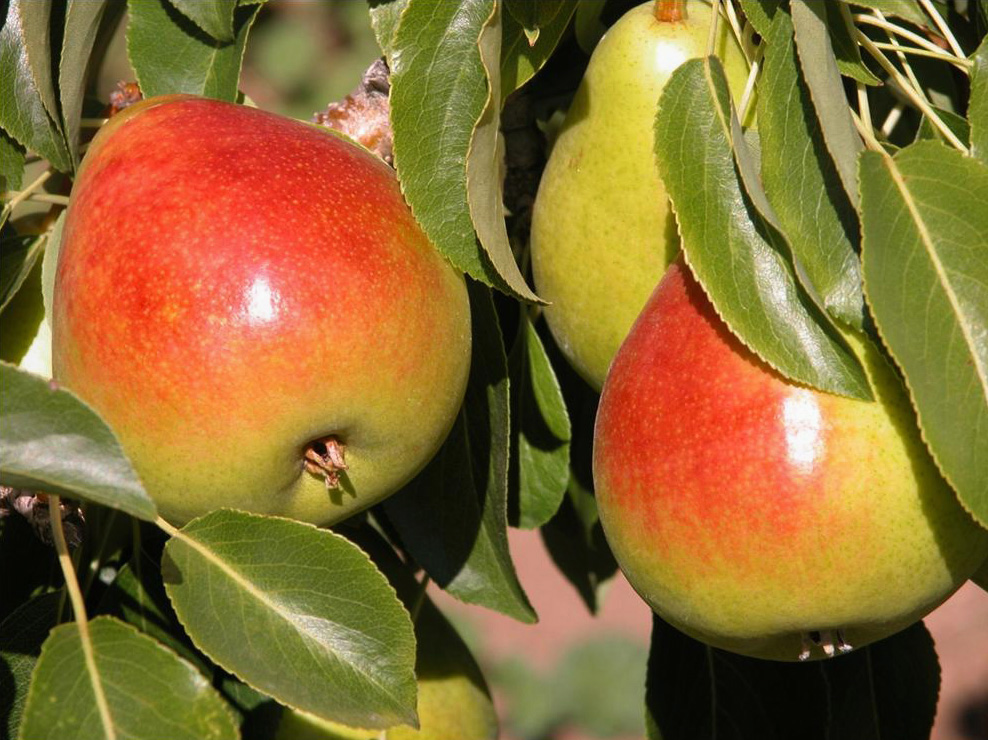| Improving Fruit Crop Traits Through Advanced Genomic, Breeding, and Management Technologies |

|

A recently released high quality and fire blight resistant pear variety

A genetically engineered plum resistant to a devastating disease called ‘Sharka’
 An ornamental peach selection with a cascading branch growth habit.
An ornamental peach selection with a cascading branch growth habit.
 A plum selection that has no ‘stone’ or ‘shell’ surrounding the seed.
A plum selection that has no ‘stone’ or ‘shell’ surrounding the seed.
Research Project: Genetic Improvement of Fruit Crops Using Advanced Genomics and Breeding Technologies
Location: Innovative Fruit Production, Improvement, and Protection
Project Number: 8080-21000-029-00-D
Project Type: In-House Appropriated
Start Date: Nov 14, 2018
End Date: Nov 13, 2023
Objective:
Objective 1: Develop, late flowering peach germplasm that is less susceptible to bloom-time cold injury using advanced breeding technologies and discovery of the genetic and epigenetic factors underpinning flowering time, chilling requirement, and dormancy. 1.A. Studies on the genetic and epigenetic mechanisms of dormancy and flowering time. 1.B. Genetically characterize the Extreme Late Blooming (ELB) trait. 1.C. Introgress later flowering traits into peach/nectarine breeding program. Objective 2: Develop enhanced germplasm with pillar and upright growth habits that will enable high density production and/or efficient mechanization and fill key genetic knowledge gaps regarding fruit tree scion architecture. 2.A. Study environmental regulation of TAC/LAZY genes. 2.B. Evaluate transgenic plum germplsam with altered architecture to assess potential agronomic value. 2.C. Perform crosses to combine pillar/upright trait with supersweet and commercial quality peach/nectarine traits. Objective 3: Develop enhanced tree fruit rootstock germplasm with dwarfing, precocity, and superior performance and fill key genetic knowledge gaps regarding fruit tree root architecture. 3.A. Create transgenic plums with altered root architectures and evaluate phenotypes. 3.B. Transform pear rootstocks with candidate apple Dw1 or Dw2 genes. Objective 4: Develop commercial high sugar peach varieties, stoneless plums, and fill knowledge gaps about agronomically important fruit developmental traits (such as flesh texture, fruit size, and sweetness). 4.A. Functionally characterize genes that control early fruit development and important fruit quality traits. 4.B. Study the impacts of down regulating lignin pathway genes on stone development. 4.C. Genetically characterized the stoneless plum trait for breeding. 4.D. Perform crosses to combine supersweet with pillar/upright and commercial quality peach/nectarine traits. Objective 5: Develop next generation biotechnology tools for genetic improvement of fruit crops as well as associated regulatory data to ease their path to market. 5.A. Develop CRISPR gene editing systems for plum and pear. 5.B. Develop regulatory data and help prepare dossier for EU deregulation of 'HoneySweet'.
Approach:
This project leverages plant breeding, genomics, genetics, molecular biology, and biotechnology strategies to address fundamental problems facing tree fruit production. The variety development and basic research activities are synergistic as the germplasm developed through the breeding efforts serve as a critical resource for identifying the genetic basis for complex traits. Many of the objectives proposed will use the unique transformation technologies developed by the investigators coupled with available genome sequences for several tree fruit species. These transformation systems have been used to develop FasTrack technology to shorten the breeding cycle for fruit tree species. Plums and pears transformed with the poplar FLOWERING LOCUS T produce flowers within the first year of growth and can be hybridized to achieve generation cycles of one to two years. Biological processes under study will include flowering time/dormancy, tree architecture, and fruit development. Regulation of flowering time in peach will be investigated using genetic, molecular and deep sequencing-based strategies. An extreme late blooming trait that avoids spring frost will be combined with commercial quality traits through conventional breeding. Tree architecture, specifically the regulation of TAC1, LAZY1, and LAZY2 expression by light, gravity, and the circadian clock, will be carried out via gene expression studies along with promoter swap experiments to determine the functional consequences of mis-expressing each gene. Collectively, these data will provide important practical information about how light regulation of IGT genes contributes to tree shape. We will continue to characterize previously created plum and apple PpeDRO1 over-expression transgenic lines and RNAi silencing lines to evaluate the impacts of over- or loss- of DRO1 function on root system architecture. In pear, we will leverage our biotechnology system to functionally characterize putative apple dwarfing/precocity genes and assess their potential to confer these traits in pear rootstocks. To study how fruit tissue determination is achieved, we have begun transcriptome-based comparisons of different fruit types, tissues, and developmental times to identify gene networks that specify properties of fleshy versus non-fleshy tissues during and after fruit set. Technology to engineer and breed for stoneless fruits will be tested using a combination of biotechnology and conventional breeding. A novel super sweet trait in peach/nectarine that confers extremely high brix (20o–30o) will be bred to develop commercial quality super sweet varieties. Methods for gene editing will be developed for plum and pear via isolation and use of novel promoters. Lastly, the research unit will continue to pursue national and international release of the transgenic plum ‘HoneySweet’ that is resistant to Plum Pox Virus (PPV). Collectively, these efforts will fill in key knowledge gaps about fundamental fruit tree developmental processes, provide new technologies for developing fruit tree germplasm with economically important traits, and lead to the development of new fruit varieties with superior traits.
